Vickers Viscount Network
October 2012 Newsletter
Dear Member
Welcome to the October 2012 Vickers Viscount Network newsletter and particularly so to those of you have joined us recently.
Our membership grows rapidly with each issue and before too long we will be topping the 1,000 mark.
Since our last newsletter we have been notified about the new memorial dedicated to the crew and passengers of the two shot
down Viscounts in Rhodesia, the Deutsche Lufthansa AG Viscount c/n 447 D-ANAF being dismantled and transported to the
Technik Museum Speyer in Germany for preservation, and the MAM - Midland Air Museum Viscount c/n 35 F-BGNR
finally being reassembled after 16 years in pieces.
Memorial dedicated to the crew and passengers of the two shot down Viscounts
On the 2 September 2012 a memorial dedicated to all those killed on Viscounts c/n 101 VP-YND and c/n 297 VP-WAS was
unveiled in the gardens of the South African Voortrekker Monument at Pretoria, South Africa and then consecrated.
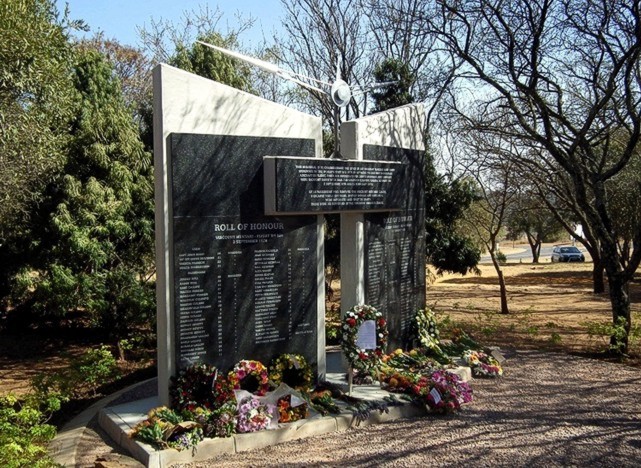
Memorial dedicated to the crew and passengers of the two shot down Viscounts
A number of family members laid wreaths around the base of the two granite plaques which has rolls of honour listing all
the names of those who sadly lost their lives.
There are still strong feelings amongst the Rhodesian communities relating to these atrocities and a general consensus of
opinion that the then free-world did little to acknowledge or condemn the actions taken by the rebels.
At long last there is a fitting tribute to the innocent victims of these events that occurred over thirty years ago.
Long may we remember them.
 History and photos of Viscount c/n 101 VP-YND
History and photos of Viscount c/n 101 VP-YND
 History and photos of Viscount c/n 297 VP-WAS
History and photos of Viscount c/n 297 VP-WAS
D-ANAF moving to the Technik Museum Speyer
In the July newsletter we reported that the Deutsche Lufthansa AG Viscount c/n 447 D-ANAF was to be replaced by a Boeing 737.
Since then we have had several reports on the progress of preparing the Viscount for the move to the Technik Museum Speyer
where it will join their collection of over 70 aircraft including the Lufthansa Boeing 747 D-ABYM.
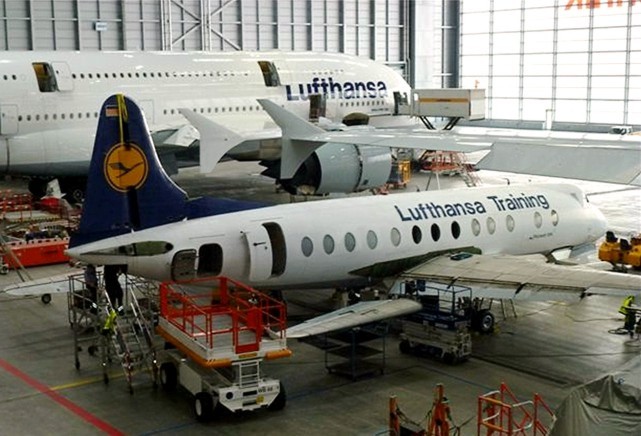
Deutsche Lufthansa AG Viscount c/n 447 D-ANAF being dismantled
Alan Lathan, who services Lufthansa's Airbus A380s has been able to see first-hand much of the progress. The Viscount
was moved into the A380 hangar where a group of Lufthansa trainees and their instructors worked on the Viscount to make it
ready for transportation. He reports;
"Other work included the building of a dock at the tail end, and one day all the doors and flaps were open or hanging down
on their hinges. Another day the wing-roots were green, as though the joints had been freed up, and I noticed a cover
missing from the base of the tail. The engine plugs were missing from 2, 3 and 4 leaving just the plain firewalls, though
no. 1 had a Rolls-Royce Dart inserted."
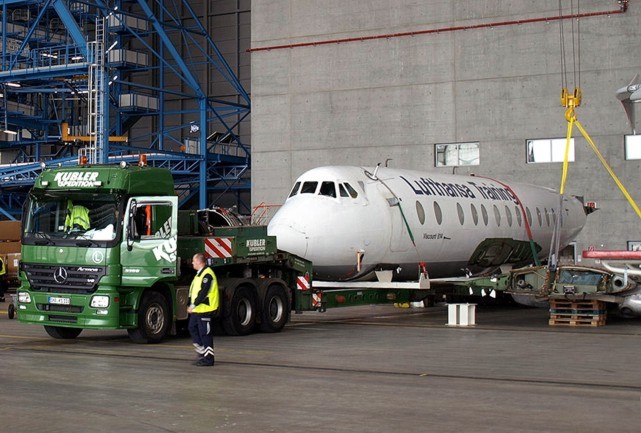
Loaded on trucks on 20 September 2012
Manfred Poznanski adds;
"After removing the horizontal stabilizer, engine, cowls, fairings, wings and vertical stabilizer the schedule was to have
the Viscount loaded on trucks on the 20 September 2012 ready for the journey to Speyer during the night, arriving at the
Technik Museum Speyer early on 21 September.
The Viscount has only been loaned to the Technik Museum Speyer by Deutsche Lufthansa AG who will retain the ownership."
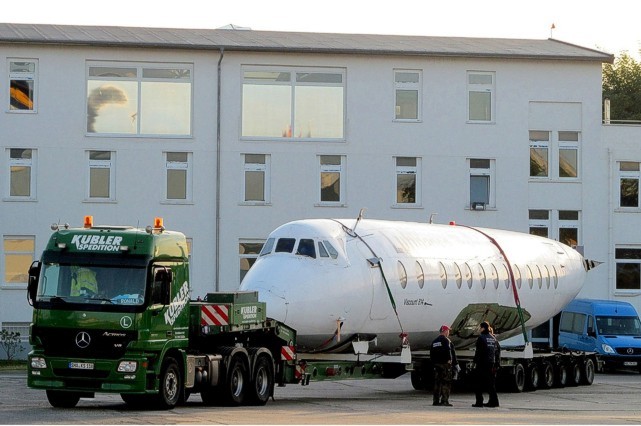
The Viscount arrives at Technik Museum Speyer in the early hours of the 21 September 2012
Holger Baschleben from the Technik Museum Speyer has provided us with a series of photos of the move that can be seen
in the aircraft's history on our website.
 History and photos of Viscount c/n 447 D-ANAF
History and photos of Viscount c/n 447 D-ANAF
 Technik Museum Speyer
Technik Museum Speyer

The fuselage now safely unloaded is put next to its Rolls-Royce Dart RDa7 Mark 525 engine
F-BGNR is back on its own wheels
On 10 September 2012 and after the planning which began in March/April Viscount c/n 35 F-BGNR has finally stood on its own
legs.
Nearly the whole of the staff of the MAM - Midland Air Museum were involved in one way or another and worked faultlessly
for the three days involved in the assembly assisting the three man professional team brought in to do the job. From the tea
and coffee supplied by the shop to the official archive cameraman, the engineers couldn't have been better supported.
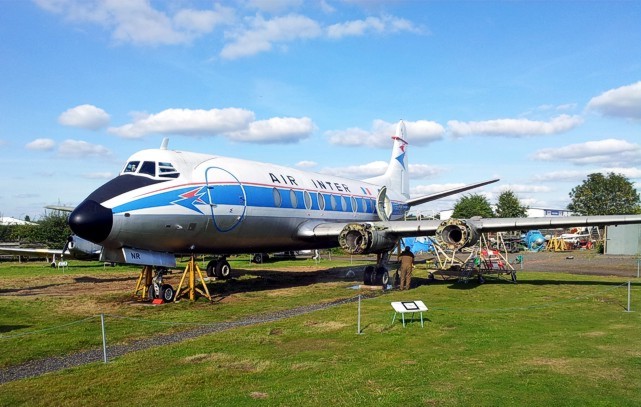
MAM - Midland Air Museum Viscount c/n 35 F-BGNR back on its own wheels after 16 years
At some stages there were a few unexpected snags such as the nose wheel being in the up-locked position. These problems were
overcome without any brute force being involved and you have to say that the British engineering inherent in the design and
construction of the aircraft, really did help us get a good strong assembly, helped greatly by some very careful preparation
of all the main assembly points.
We were impressed by the quality of the County Lifting supplied cranes involved, one of which was only released for use some
two days before the lift, this being its first real job. They all performed faultlessly and kept within the air traffic
regulations that were issued.
The weather held out (just) with very little wind which made the tricky assembly job just that much easier to accomplish.
The process doesn't end there of course as it’s only the beginning of the long haul to make the Viscount into a presentable
exhibit, but it’s a major step that allows those at the museum now, and those that follow, can build on for the future.
 History and photos of Viscount c/n 35 F-BGNR
History and photos of Viscount c/n 35 F-BGNR
 MAM - Midland Air Museum
MAM - Midland Air Museum
Is it possible to bring the last 'airworthy' Viscount back to the UK?
Viscount c/n 170 9Q-COD, ex BEA - British European Airways G-AOHV, that is owned by GTRA Airways in the Democratic Republic
of the Congo, is currently up for sale.
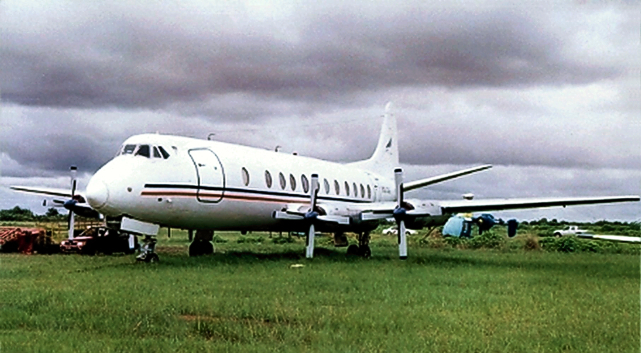
GTRA Airways Viscount c/n 170 9Q-COD that is currently up for sale
Vickers Viscount Network core members Clive Worboys and Jamie Popplewell are researching this complex and
expensive project to see if it will be possible to once again have a Viscount flying in the UK.
Clive and Jamie are keen to hear your views, support and questions on this potential project. Please email them at:
 email - G-AOHV@VickersViscount.net
email - G-AOHV@VickersViscount.net
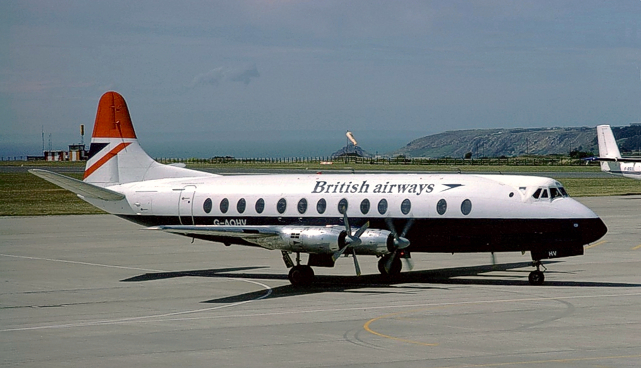
BA - British Airways Viscount c/n 170 G-AOHV in August 1977
 History and photos of Viscount c/n 170 9Q-COD / G-AOHV
History and photos of Viscount c/n 170 9Q-COD / G-AOHV
Last UK Viscount passenger flight
In an earlier newsletter we recorded details of the last Viscount flight from Heathrow, London, England on the 18 April
1996. Colin Carr commented;
"You featured the Viscount finale at Heathrow. While this was undoubtedly the last Viscount operation at Heathrow, it was not
the end of Viscount passenger operations.
As mentioned in the histories of Viscounts c/n 162 G-AOHM and c/n 382 G-APEY, G-APEY was hurriedly ferried down from Aberdeen,
Scotland to Heathrow after the originally scheduled aircraft G-AOHM was damaged at Stansted, Essex in a towing accident.
I was working for BWA - British World Airlines in Aberdeen as an operations controller at the time. Shortly after getting the
first two flights of the day off to Sumburgh, Shetland Islands, Scotland I was called by BWA's Operations Director and asked
(well told I suppose) to get G-APEY ferried down to Heathrow.
This meant pulling it off its contract passenger work for Shell Expro. It also meant not saying anything to Shell until Echo
Yankee was already in the air headed south. They were definitely not pleased when I told them their aircraft had been borrowed.
I referred them to Head Office at Southend.
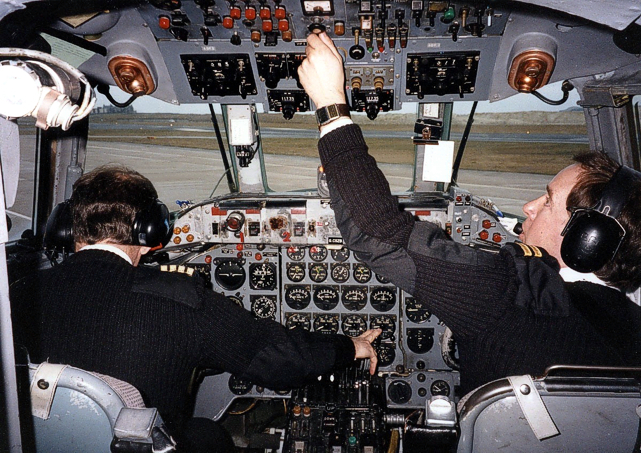
G-CSZB preparing to leave Sumburgh, Shetland Islands, Scotland
Viscounts continued carrying passengers for Shell on their Aberdeen - Sumburgh - northern oil platforms operation until the
end of June 1996. The final Sumburgh flight was on Saturday 29 June, with Captain Peter Meldrum in command of the ex
NAC - New Zealand National Airways Corporation Viscount c/n 248 G-CSZB.
Despite typical Shetland summer weather (overcast, cloud base about 400 feet), Peter was determined to say farewell to
Shetland Viscount operations with a low fast flypast over the airfield. I was lucky enough to be on board and remember being
in and out of cloud as we circled for the 'beat up'.
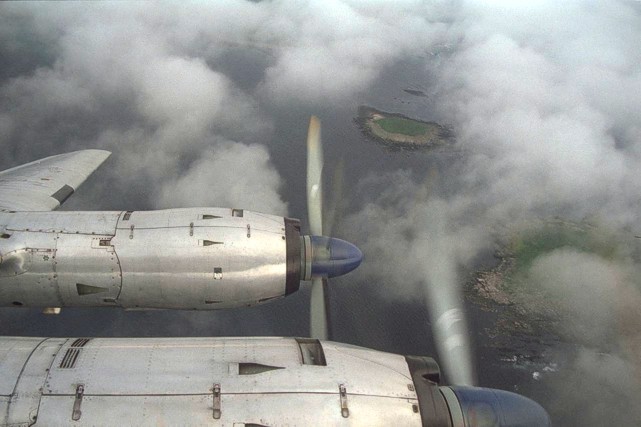
G-CSZB over the Shetland Islands, Scotland
It took someone who knew Sumburgh and its adjoining high ground very well, to safely position for the low pass along Runway 33.
Peter succeeded. Had he got it wrong, we'd have made the front page of next morning's papers for all the wrong reasons!
My most vivid recollection of that low, fast pass was looking over towards the Bristow Helicopters hangar, and realising we
were below its roof! After that we climbed and set course for Aberdeen, which was very routine and boring by comparison.
Next day, Shell used Zulu Bravo for a company social club day out in Newcastle. That was their last Viscount flight, though
Zulu Bravo remained on standby at Aberdeen until the end of July to cover any possible problems with the new ATR 72s, which
had replaced the old lady.
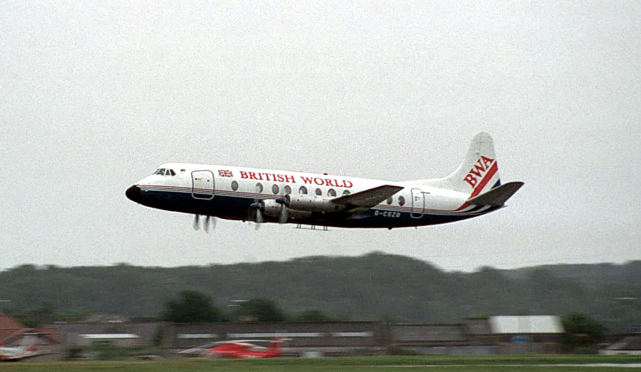
G-CSZB climbing after a low pass along Aberdeen's runway 34
31 July was another wet day with a low cloud base, and again Peter Meldrum was in command as Zulu Bravo was ferried
to the BWA base at Rochford, Southend, Essex, England. Again, he managed a low fast pass over Aberdeen's runway 34 before
climbing into the clag and ending Viscount operations at Aberdeen.
Heli-Jet Aviation Ltd. purchased some ex BWA Viscounts, including G-APEY. I was lucky enough to be a passenger on board her
final day of UK domestic Viscount passenger operations.
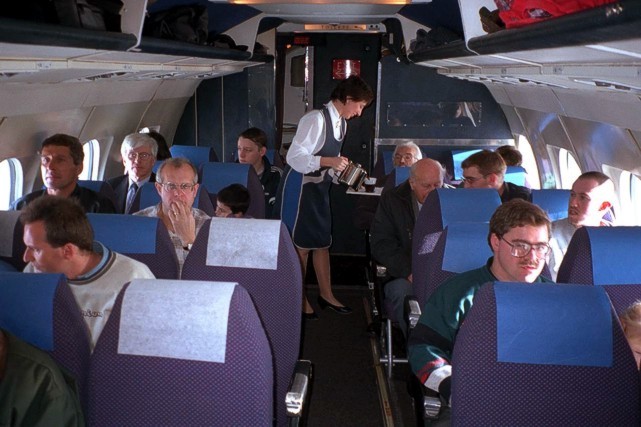
G-APEY on her final day of UK domestic Viscount passenger operations
It was 30 November 1997. We had a morning departure from Southend to Bournemouth, then a local flight over the Isle of Wight
and a tea time return to Southend. Guess who was in the right hand seat, Peter Meldrum of course.
 History and photos of Viscount c/n 162 G-AOHM
History and photos of Viscount c/n 162 G-AOHM
 History and photos of Viscount c/n 248 G-CSZB
History and photos of Viscount c/n 248 G-CSZB
 History and photos of Viscount c/n 382 G-APEY
History and photos of Viscount c/n 382 G-APEY
Printable version of the newsletter
Some readers like to print off the newsletter rather than, or in addition to, reading it on screen. If you wish to print this
issue, simply click on the 'Newsletter printable version' button, which appears near the 'small print' at the bottom of the
page, enabling you to produce a printable version configured to save you a lot of ink.
Delivery flight of CF-THS from Winnipeg to Montreal – a surprise in store
Documentation of the massive Robert Arnold collection has been recorded in previous newsletters and continues to be
full of surprises. In his latest report Robert says;
"I have a complete package containing the final maintenance records and the preparation details for Viscount c/n 279 CF-THS
last ferry flight from Winnipeg to Montreal, Canada after being purchased by Beaver Enterprises.
The list below shows the equipment that was on CF-THS, and the engine and prop serial numbers which are of interest.
The yellow journey log states the aircraft met all standards for this flight. It is dated September 28 and 29, 1976.
Hope this is useful. I will search for more as time goes on."
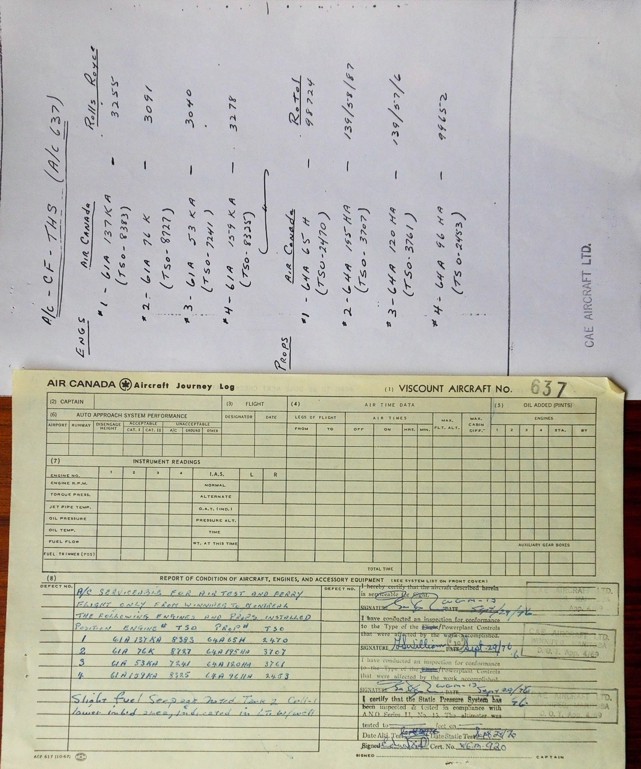
Viscount c/n 279 CF-THS ferry flight details from the Robert Arnold archive
Imagine core member Jack Stephens' delight in seeing the above. He replied;
"Hello Robert, what a pleasant surprise! That is my Dad's (B A Stephens) signature certifying the aircraft. I have
sent a copy to his youngest son Bob, and to his grandson, Bill.
You will recall when you first started to sort out your Viscount archive I asked you to keep an eye out for his signature.
I was confident that this would happen one day. Thanks for this precious discovery."
 History and photos of Viscount c/n 279 CF-THS
History and photos of Viscount c/n 279 CF-THS
Gear leg assembly – a query
Robert has another query from the material that he is finding in his massive collection. He asks;
"Here is another Vickers-Armstrongs photo from my collection. Question: is this photo of a main undercarriage leg or nose
undercarriage leg? I think it is the nose gear."
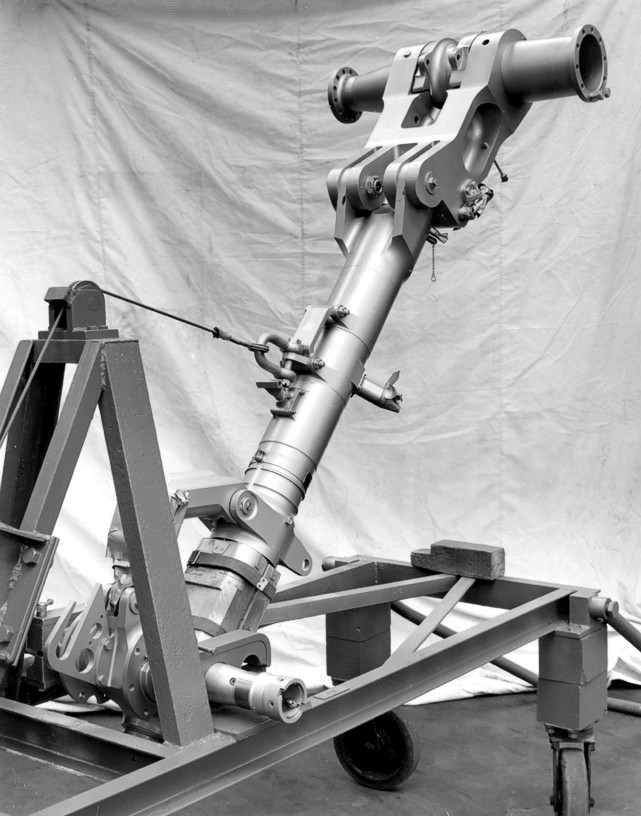
Is this photo of a main undercarriage leg or nose undercarriage leg?
Core member Simon Ellwood replies;
"This is definitely a main undercarriage leg - note the retraction pivot point about a quarter of the way down where the
leg pivots and folds during retraction (the nose leg does not break and pivot in two parts as the main leg does). The
down-lock mechanism can just be seen sticking out from the rear face of the leg at this point. Just below where the
supporting cable is attached is the up-lock lug (looks like a 'T' when viewed from below). The nose undercarriage leg
doesn't have this.
1957 Capital Airlines check flight
Carl B. Jordan reports;
"In a previous issue, retired United Airlines B-747 captain Terry Davies wrote an item that also stirred memories
of my own. He commented how as a teenager, he watched Viscounts climbing out of DCA (Washington National Airport) with one
engine feathered. He surmised that they were 'training flights'.
That might well have been the case, but they could also have been check flights.
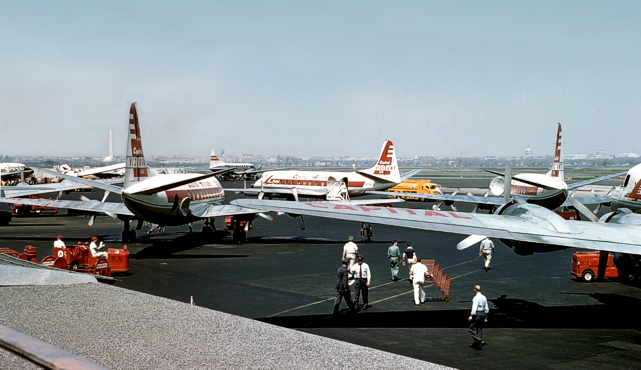
Washington National Airport as Carl would remember it from the 1950s
Back then our six-month check flights were conducted in the actual aircraft inasmuch as there were not yet any flight
simulators sophisticated enough to be able to be approved by the FAA to be utilised for rating rides and check rides in
lieu of using an actual aircraft.
I recall in 1957 when, as a Viscount co-pilot for Capital Airlines, I was on a check ride with Captain John Maurer
who occupied the left seat. At the time of the flight he was the captain representative and chairman of our Chicago
council of the Air Line Pilots Association (ALPA). I was the elected co-pilot representative and occupied the right seat.
It was the only time that we flew together on a 'hood check.'
Captain Hank Wygel was giving us the required check ride and he occupied the middle jump seat.
John had to demonstrate a take-off on runway 18 at DCA in which, to nobody's surprise, Hank caused #4 prop to auto-feather
just past V-1, the 'critical engine failure speed.' John lifted off on three engines and climbed out over the river,
southbound.
Hank chided John for flying a bit faster than the prescribed V-2 speed. John commented that he felt better doing that 'just
in case another engine decides to quit'. He assured Hank that if it were a real-world situation, he could 'nail the
prescribed V-2, and both of us know it, Hank'.
John was confident that he would pass the check ride, despite his minor 'transgression', it turned out that he did.
After doing the required 'air work' (approach to stalls, etc.) John returned to DCA and made a three-engine landing. I then
had to demonstrate the same kind of take-off which, by the way, both of us flew 'under the hood'.
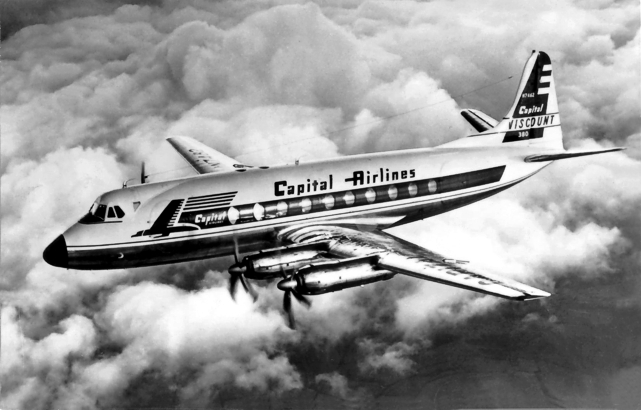
Capital Airlines Viscount c/n 217 N7462
Again Hank auto-feathered #4 just as we passed V-1, and I locked onto the prescribed V-2 speed and lifted off. As a
relatively junior co-pilot, I didn't have a close enough relationship with Hank that I could 'fudge' on the airspeed, and
talk my way out of it. So, I took pains to keep the airspeed right on the specified number.
As we climbed out over the river at V-2, John got 'antsy' in the left seat. He squirmed and looked uncomfortable. Hank said
'What are you nervous about, John? Unlike you, Carl's doing a great job of nailing the specified V-2 speed.'
John said 'Well, what if another engine would quit right now?'
Hank said, 'That's no problem, John!' At that, he reached up and auto-feathered #3 engine! Wow! With two engines out on the
same side, I did all I could do to hang on to V-2 and keep the bird pointed straight ahead. It was tough, but I managed to
do it. However, we were certainly on the ragged edge!
John was really squirming now. His hands were hovering over the control yoke, but things were so tight that he didn't want
to interfere with the touchy situation. (He confirmed this to me later.)
Hank said, 'See, John, it's no sweat. With an empty airplane we can still hold our own at V-2 with two engines out on one
side. You should have more confidence in Carl'.
Incidentally, since the Viscount's Rolls-Royce props rotated 'backwards' compared to American manufactured engines,
counter-clockwise rather than clockwise, when viewed from the front, the critical engine, torque-wise, was #4 rather than
#1, such as would be the case on a DC-4. We felt this state of affairs was a carryover from the British habit of driving
down the left side of the street.
Also, unlike the case with the American-made engines, feathered engines on the Viscount didn't remain stationary. They
rotated slowly in the proper (forward pitch) direction. This was done to keep accessories - fuel pumps, hydraulic pumps,
generators, etc. moving in the proper direction. Otherwise, they might have tended to spin in backwards, thus causing
further problems.)
John said 'Dammit, Hank, enough is enough! Now fire up that engine. And, if you ever pull a stunt like that again, I'll
punch you in the nose!' Obviously, John and Hank had a relationship that tolerated such 'disrespect' on John's part.
We weren't climbing, but we weren't descending, either. The tower noted our 'predicament' and inquired if we were declaring
an emergency. Hank assured them that 'all is well' and we did fire up #3 engine. After all, I too still had to do some air
work, and I was still required to make a three-engine landing to check-off all the squares that had to be checked-off the
six-month check ride.
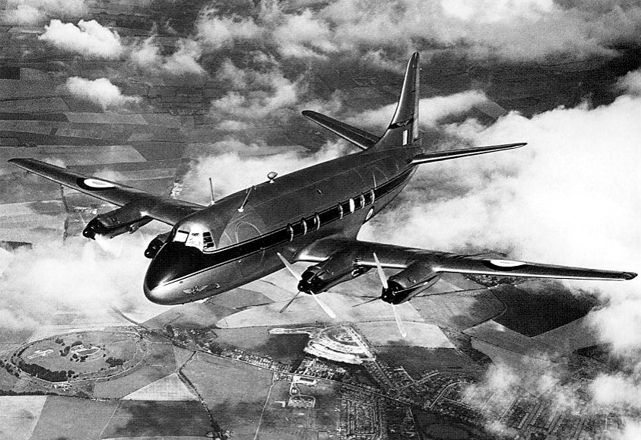
Prototype Viscount c/n 1 VX211 with both propellers on the port engines feathered
I never blamed John for getting 'antsy'. After all, back then there were several fatal crashes which occurred during
training and check rides. When Hank feathered that second engine, we had absolutely NO margin for error. Obviously, John
didn't like it. However, in accordance with his reputation as a check pilot, it was just Hank's way of proving a point.
You just never knew what kind of trick he was going to pull.
Back in the 1950s, it was common to see a Viscount climbing out of DCA with #4 engine feathered, and wind milling very
slowly in the proper direction. However, I doubt that there were very many that were seen flying with BOTH props on the
right side feathered. Once was certainly enough for me!"
And again on two engines - port this time
Michael Joyce reflects again on his Viscount days
"During the late 1970s I was a CAA inspector in Toronto, Canada. In March 1978 I was given the task of checking out a crew
on ex TCA - Trans-Canada Airlines Viscount c/n 383 CF-TIC.
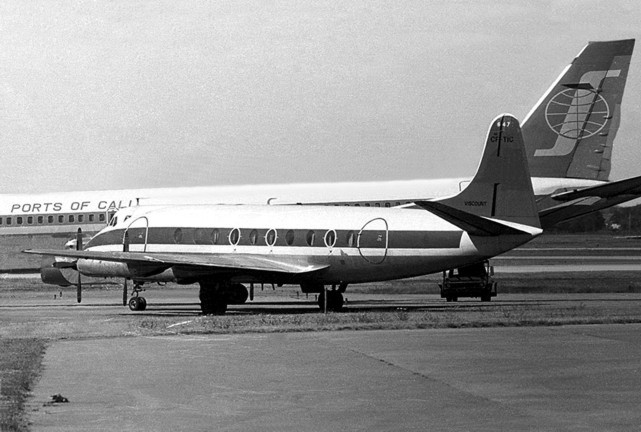
Pier 1 Aviation Viscount c/n 383 CF-TIC
This aircraft had lain dormant on the northeast side of TIA for some time. It had been purchased by a consortium, Pier 1
Aviation, for charter work and two crews required checking out for licence endorsement.
I remember the lead captain as a fellow with the last name Benson, an ex Winco from the RCAF. We flew to London, Ontario and
did the usual.
However on trying out an approach with two engines out on the left side it became obvious that we wouldn't make it and
returned the engines to normal. When back at TIA I suggested that the engines might be down on power. The aircraft remained
there for some time and one day it was gone, no idea what or where.
I was given this job as being the only pilot in Transport Canada Toronto office to supposedly know something about the
Viscount. Lots of trust as the last time I had touched one was 15 years earlier!"
 History and photos of Viscount c/n 383 CF-TIC
History and photos of Viscount c/n 383 CF-TIC
British Columbia Aviation Museum, Sidney, British Columbia, Canada
On 20 June 2012 core member Jack Stephens visited fellow core member Dave Peters at the British Columbia
Aviation Museum. Dave is part of the team who are restoring Viscount c/n 224 CF-THG.
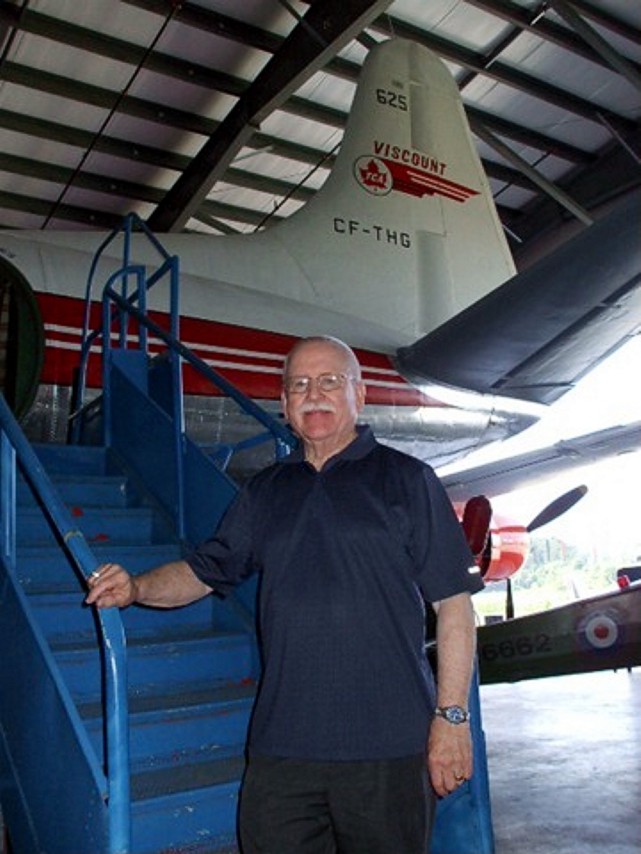
Core member Jack Stephens visited Viscount c/n 224 CF-THG
During his visit Dave showed Jack where the water-methanol units were removed from the Rolls-Royce Darts and his
understanding of why they were removed.
Core member Brian Powell commented;
"I was reading recent correspondence on the Vickers Viscount Network private forum about the removal of the water-methanol
systems from the TCA - Trans-Canada Air Lines Viscounts.
As I remember it, TCA was amongst the earlier companies to order the Viscount. Water-methanol was injected at take-off power
to reduce TGT in high ISA conditions. As such, its installation was probably specified in the original TCA contract.
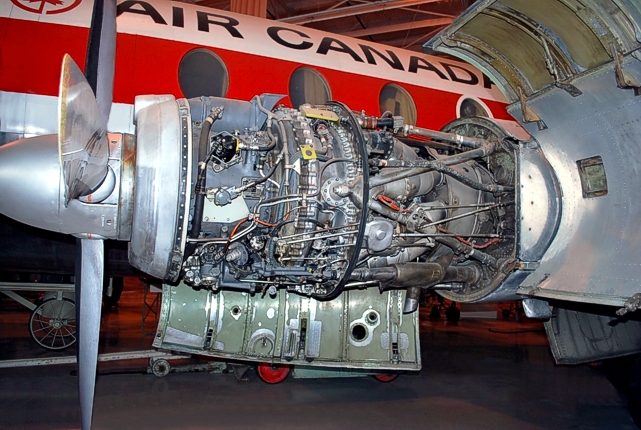
Western Canada Aviation Museum Viscount c/n 279 CF-THS
showing where the water-methanol control unit has
been replaced by an aluminium sheet housing
I also remember that in those earlier days, I attended regular visits to the Rolls-Royce School in Derby, England to keep
myself up-dated on the improvements in the Dart engines as they were introduced. As an example, I recall learning about the
considerable development of the metallurgy of the turbine blade materials which improved their resistance to higher TGT's in
high ISA take-off conditions.
Is it possible that when these improvements were incorporated, it became unnecessary to use water-methanol on the TCA
network? In such an event it would only be common sense to remove the water-methanol installations to reduce airframe tare
weight and thereby increase load capacity."
Thanks Brian, does anyone wish to add to this explanation?
 History and photos of Viscount c/n 224 CF-THG
History and photos of Viscount c/n 224 CF-THG
 History and photos of Viscount c/n 279 CF-THS
History and photos of Viscount c/n 279 CF-THS
What produced the distinctive Rolls-Royce Dart sound?
Bill Dempster, who flew on all the BA - British Airways Viscounts in his time (1960/82) with great pleasure in the UK
and Germany, as well as the Avro/Hawker Siddeley 748s in later years, recently asked Vickers Viscount Network co-founder
and Rolls-Royce Dart engineer Brian Burrage about the sound of the Rolls-Royce Dart;
"I work on the team maintaining the Vickers Varsity T.1 WF372 at the Brooklands Museum because of my navigational interest but
a good part of my life in BEA/BA was spent handling Viscounts at Heathrow, London, England, Berlin, Germany and Stornoway,
Isle of Lewis, Outer Hebrides, Scotland as an apprentice in the traffic branch 1963/66 and then on the permanent staff.
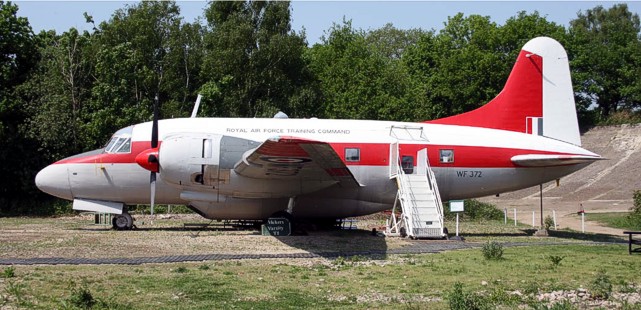
Vickers Varsity WF372 at the Brooklands Museum
As there was no Station Engineer at Stornoway I used to cover the starts (hand signals) on the Viscount, pulling out the
trolley/acc plug and chocks when the Darts were running. Also part of the duty was to stand by with the fire extinguisher,
which thankfully never was required. Access behind the prop!
As there were no earplugs or defenders in those days on the ramp, the noise was horrendous and caused temporary deafness
resulting eventually in tinnitus and loss of hearing.
So I would like to know what was the actual noise produced at 6-10 feet by the Darts in idle. No-one including air crew,
engineers, nor even the archives, has come up with anything on the Dart noise so I come to you as a potential source of
information."
Brian replied;
"I have often been asked this question as most people were under the impression that it was a gear meshing within the
reduction gearbox, which is totally incorrect. The sound is a result of the steel rotating guide vanes (RGV) fitted to the
front of the aluminium low pressure (LP) and high pressure (HP) compressor impellers.
At take-off, the impellers rotate at 14,500 rpm on the RDa3 and RDa6 engine and at 15,000 rpm on the RDa7 and RDa10 engine
and the RGV vane tips are generating the distinctive sound heard outside. The magnesium and aluminium casings that surround
the LP and HP impellers act like echo chambers, which focus the unique sound (not noise!).
Even at ground idle (6,000 to 7,500 RPM) the sound is still there as you have personally experienced at close quarters. To
further prove this, Rolls-Royce introduced an improved efficiency RDa7 engine (Mod 1860) in the early 1980s. This incorporated
LP and HP impellers manufactured from aluminium without the need for a steel RGV and the sound was dramatically reduced.
If you fitted this type of engine, together with an air intake cowling with an acoustic hush kit (Mod 1800), then the sound
was even lower. Sadly, none of the improved modifications made it to the RDa7 powered Viscount.
Keep up the good work on the Varsity."
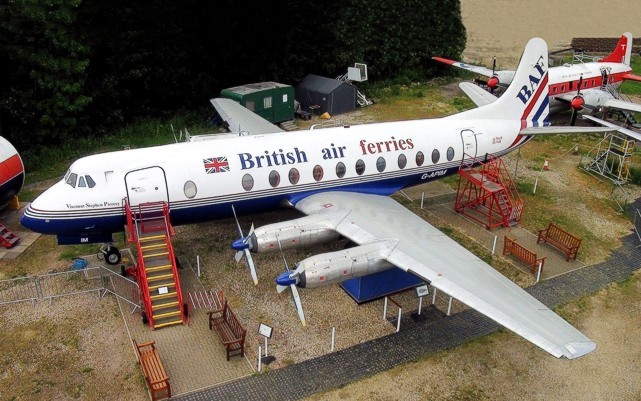
Viscount c/n 412 G-APIM at Brooklands with Varsity WF372 in the background
Viscount disaster near Parrotsville, Tennessee – nearly 50 years ago
Tom Dier of Greeneville, Tennessee recently advised;
"I live a few nautical miles from the crash site of United 823 that occurred 9 July 1964. It appears that my house lies near
the plane's final flight path. The aircraft was United Air Lines Viscount c/n 103 N7405."
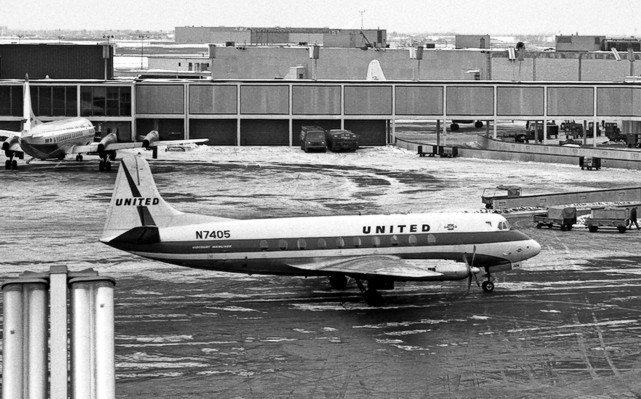
Viscount N7405 at a wintery Chicago O'Hare on 31 January 1963
"As you may know, N7405 was destroyed to the point that it was next to impossible to determine the exact cause of the on-board
fire, and that much information appearing on the internet as well as the final report from the Civil Aeronautics Board is
speculative.
Reading the report, I found that there were several automatic fire extinguishing systems. References also mention portable
CO2 extinguisher(s) possibly used by the First Officer in an attempt to extinguish a fire in an under floor cargo compartment.
Mention is also made of a cargo compartment CO2 extinguisher being fired 'electrically'.
If you could describe the nature of the automatic systems for the Viscount and how their usage would differ from
extinguishers that were meant to be used manually, I would be most appreciative."
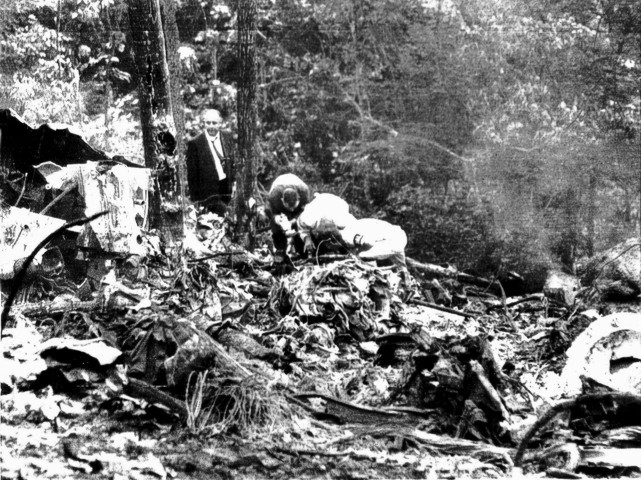
Inspectors sifting through the wreckage on the day after the crash of N7405
"It will soon be 50 years since this disaster took place. The reason for my research is to provide information commemorating
this event in local newspapers in the form of a human interest article.
It is remarkable that since my wife and I moved to this area over thirty years ago, neither of us ever heard mention made by
our neighbours of United 823 until recently. On top of that, some people who were small children at the time have no recall of
the event ever being mentioned by those who were adults in 1964, such as parents or grandparents.
The United 823 crash is the largest disaster to have taken place in the state of Tennessee. I feel that this is a story worth
telling and if you could provide me with some technical data, I would be most grateful."
In response, Brian Burrage guided Tom, who had found our site as part of his research, to the history and pictures of
N7405, which is quite extensive.
 History and photos of Viscount c/n 103 N7405
History and photos of Viscount c/n 103 N7405
Who was the first woman to fly the Atlantic in a turbo-prop aircraft?
From Terry Baker in Canada we learn of this report from the Edmonton Journal dated 9 May 1955;
Being married to a test pilot is "just like being married to a bank clerk - in a way" says Mrs Jock Bryce. The pretty
brunette who was born at Ocean Falls, British Columbia, Canada is the wife of the chief test pilot for the British aircraft
manufacture Vickers-Armstrongs.
Fortified with a plentiful supply of air sickness pills, she became the first woman to fly the Atlantic in a turbo-prop
aircraft. This came about when she accompanied her husband on a trans-Atlantic trip while he ferried a new Viscount to TCA -
Trans-Canada Air Lines."
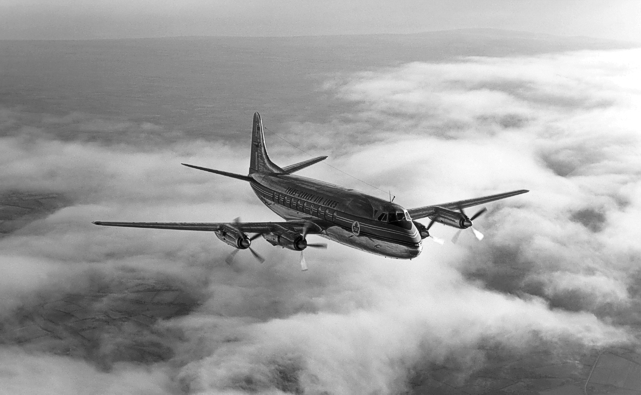
TCA - Trans-Canada Air Lines Viscount c/n 40 CF-TGI taken in November 1954
Model Decals Available
Core member Allan Taylor in Australia has model decals available and reports;
"I have bought up quite a few decal sets to suit Viscounts and other Australian airliners. My dream was to build a scale
diorama of Brisbane's Eagle Farm Airport set in the 1960s. However I now think that trying to do a realistic scale airport
model 'true to detail' may be biting off more than I can chew."
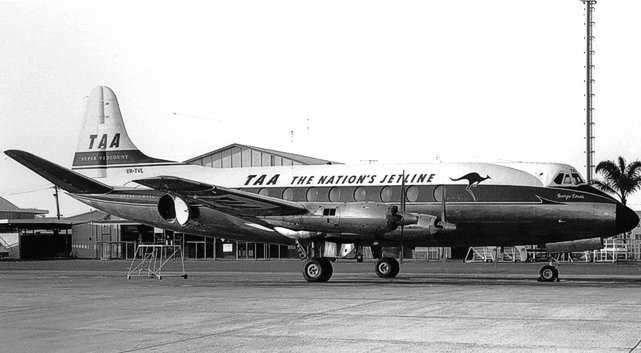
TAA - Trans-Australia Airlines Viscount c/n 197 VH-TVL taken at Eagle Farm Airport
"I decided to standardise on 1/72 scale but some decals I have are 1/96 scale. I may have to settle for several smaller
dioramas of fictitious airports so that various dioramas can be in various scales. Alternately I could sell the model kits
and decal kits, which are non-1/72 scale.
If anyone has messed up a decal, or has broken, or is missing a part let me know as I may be able to help. The Mach 1/72 kit
has Capital Airlines and BEA - British European Airways decals, the Glencoe 1/96 kits have Air France, Northeast Airlines,
Capital Airlines, and BEA - British European Airways decals. I don’t expect to be using any of those decals.
I will also have some leftovers from the Ansett ANA and TAA decal kits as they cater to a variety of colour schemes and
registrations. Once again, if I can be of any help I certainly will be."
 Email - Allan.Taylor@VickersViscount.net
Email - Allan.Taylor@VickersViscount.net
Another Australian model maker
Graeme Thom also in Australia has sent us this stunning photo of his Glencoe model completed as VH-TVH. It looks real!
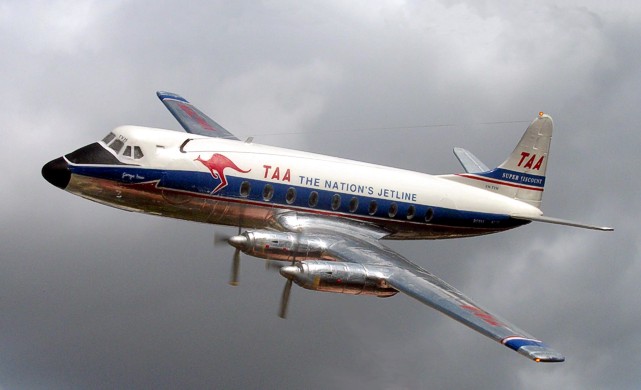
Graeme Thom's Glencoe model of VH-TVH
Philatelic Contribution
Chris Spencer has made the suggestion that we have a Philatelic Corner and has sent in these examples.
"Since early in the 1950s there have been many covers flown on Viscounts and quite a number of stamps issued illustrating
our favourite aircraft. Probably the earliest flown were with BEA - British European Airways and whilst Britain was slow in
issuing anything philatelic, other countries did rather well.
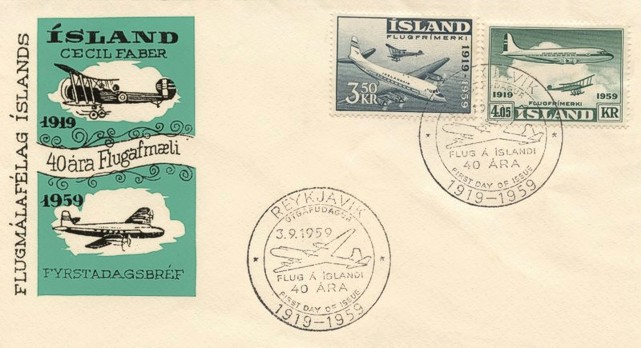
First day cover celebrating forty years of Icelandic Civil Aviation
One of the earlier actual stamps came from Iceland - in 1959, and the lower of two values celebrating forty years of
Icelandic Civil Aviation showed Icelandair Viscount c/n 149 TF-ISU - the second of their two Viscounts.
The other stamp illustrates an unidentified Douglas DC-4. Illustrated is a First Day Cover for the stamps and I am uncertain
which of the two four-engine planes is intended to be illustrated in the cancellation.
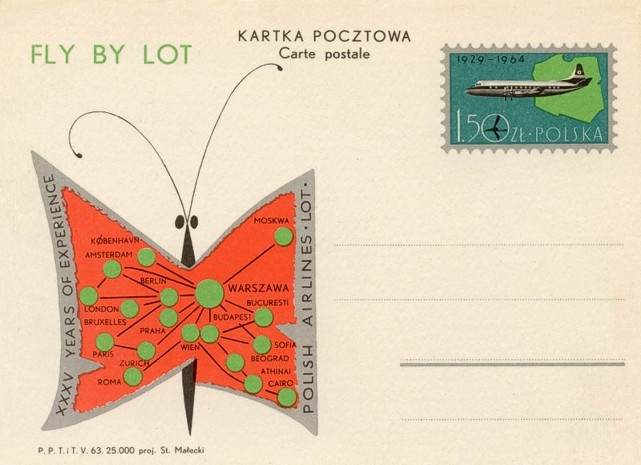
LOT - Polskie Linie Lotnicze prepaid postcard celebrating their 35th anniversary in 1964
LOT - Polskie Linie Lotnicze had three V.804 Viscounts (SP-LVA to SP-LVC) and as a part of the publicity for their 35 year
anniversary in 1964, they produced a prepaid postcard (presumably for the benefit of paying customers), which shows a route
map of their services. The prepaid stamp is a quite fine illustration of one of their Viscounts.
On 18 April 1996, the last official Viscount passenger flight took place from Heathrow and aptly over-flying both Brooklands
and Wisley, but even more appropriately carrying, amongst others, George Edwards.
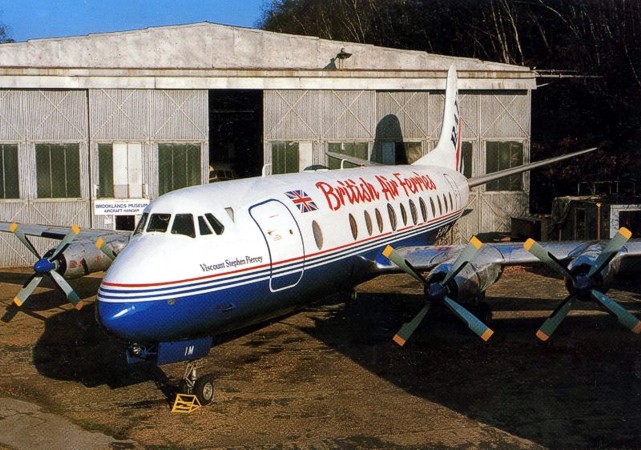
A limited number of illustrated postcards were flown on the last Viscount flight from Heathrow
A limited number of illustrated postcards were flown and indeed signed. The illustration is naturally of G-APIM, and
illustrated are both front (picture) and reverse (stamp and signatures), plus two 'John Bull' cachets identifying the details
of the flight and the Brooklands involvement.
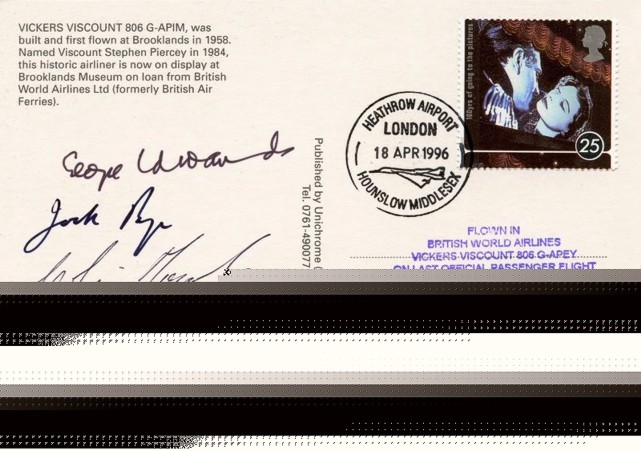
The card was signed by the crew of Viscount c/n 382 G-APEY
I have also found a number of hitherto unpublished (and forgotten) Viscount pictures and slides taken by me in the late 1950s
and onward. Again I attach one to see if there is any merit in also sharing them."
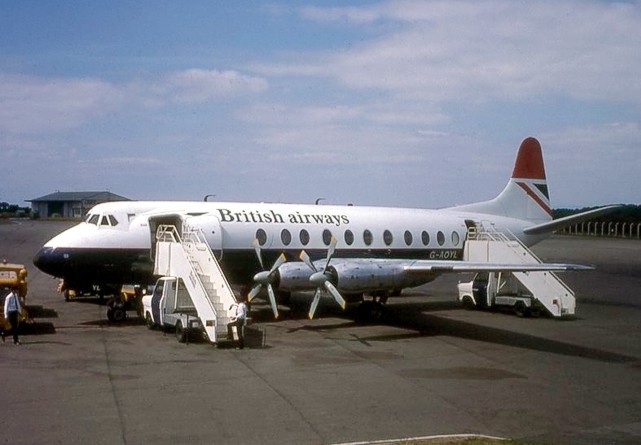
Chris Spencer photo of BA - British Airways Viscount c/n 261 G-AOYL taken at Lulsgate, Bristol, England
Thanks Chris and we intend to make this a regular feature of our newsletters. We look forward to receiving more of your photos
and post cards.
Accident to Viscount G-ANRR
Core member Alan Beardmore has written in concerning the accident of the Hunting-Clan Viscount c/n 74 G-ANRR on 2
December 1958. He also sent in newspaper reports, which are interesting to read but too large to include in this newsletter.
He writes;
"As an aircraft engineer I am more interested in the technical development of the Viscount family. In particular, the
resulting changes that were made as a result of incidents. Of special interest is the accident to G-ANRR which was being
operated by Hunting-Clan and crashed on an air-test following major maintenance."
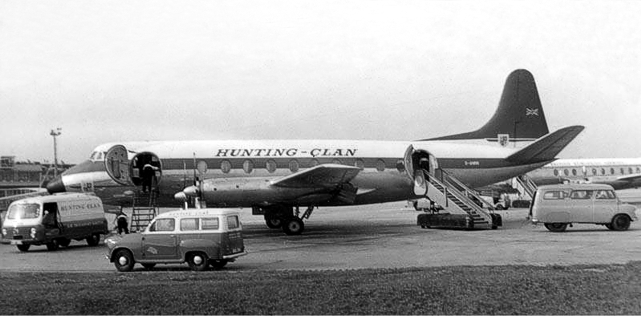
Hunting-Clan Viscount c/n 74 G-ANRR a few months before the accident
"It was concluded that the cause was the incorrect rigging of the elevator spring tab. This tab is one of two on the Viscount's
left elevator (the other being the anti-balance tab) and it's purpose is to assist the pilot moving the elevator once the
pilot has exceeded a certain pre-set force on the control column. It uses a spring tensioned so that at low control column
forces the tab does not move relative to the elevator, but once the pilot exerts more force than the pre-set, the tab moves so
as to effectively 'power assist' the elevator.
The engineers involved in rigging the tab were able to make the tab operate in a reverse sense, and as a result of the
accident a series of modifications were implemented to prevent a recurrence. They included operating rod taper pins being
left extruding and being painted red to indicate the direction of fitment. Other modifications included interference
brackets being fitted on balance tab and spring tab mechanisms."
Core member Brian Powell adds;
"I have first-hand knowledge of the accident to G-ANRR. It was a sorry tale of a catalogue of incidents leading to an
accident, coupled with rank bad engineering and inspection practice, and lack of senior administrative liaison between the
engineering company who did the maintenance and the operating company.
In fact, as Chief Training Captain and company test pilot for Hunting-Clan, I should have been in my friend Rex
Mulliner’s place had it not been that I was on a DC-6 training flight in Nairobi at the time."
 History and photos of Viscount c/n 74 G-ANRR
History and photos of Viscount c/n 74 G-ANRR
Aftermath of the accident to G-ALWE at Manchester
The accident at Wythenshawe, Manchester, England on the 14 March 1957 involving BEA - British European Airways Viscount c/n 4
G-ALWE is covered in the records section of our website where we record;
PROBABLE CAUSE: It appeared that the starboard aileron became locked when the No.2 flap unit moved away from the
trailing edge following failure of a lug and bolt in the flap fitting. The fracture of a 9/16 inch bolt holding the bottom of
the No.2 starboard flap unit was probably caused by metal fatigue.
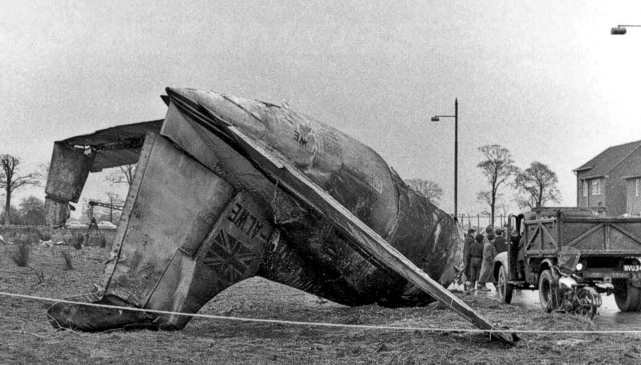
Wreckage of Viscount c/n 4 G-ALWE after crashing at Wythenshawe
Recently core member Ed Jones has sourced from the United States the official report which is over 30 pages long. It
says;
Fatigue failure is always a serious issue and Vickers-Armstrongs went to great lengths to find the solution.
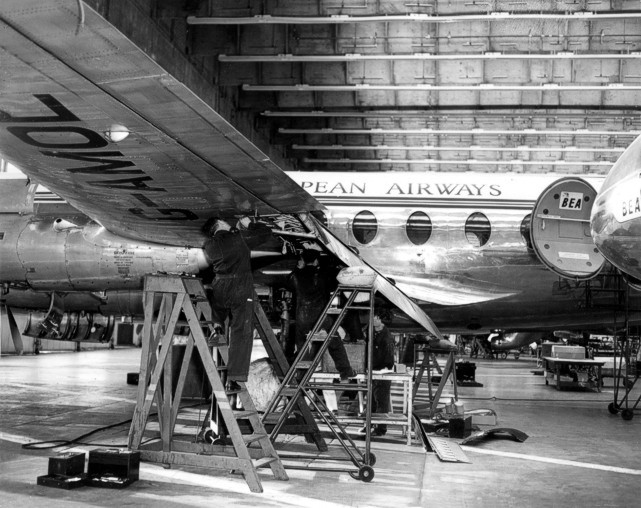
BEA - British European Airways Viscount c/n 25 G-AMOL undergoing wing flap modifications
Here we can see a Viscount airliner that will be used as a 'guinea pig' to investigate the bolt fatigue which brought about
the Manchester Airport crash.
Vickers is determined to make absolutely sure that their world beating plane will be 100% safe
in the future. The first step has been to replace every wing flap bolt in every Viscount which could possibly be in danger.
 History and photos of Viscount c/n 4 G-ALWE
History and photos of Viscount c/n 4 G-ALWE
 History and photos of Viscount c/n 25 G-AMOL
History and photos of Viscount c/n 25 G-AMOL
Australian Viscount seating
Alan Parker has followed up with more information on the Australian Viscount seating discussed in the August
newsletter. He comments;
"I had the sometimes good fortune to be a First Officer on ANSETT-ANA V.832/V.720/V.747 Viscounts during the 1960s and the
memories are still very clear.
The Viscount kept us quite busy, particularly on short legs, Wynyard Devonport/Launceston Hobart/Sydney Canberra/ and others.
The V.832s were essentially the best aircraft although the ex TAA - Trans-Australia Airlines V.720s had the nicest stick
and rudder feel - the less said about the ex Butler Air Transport V.747s the better!
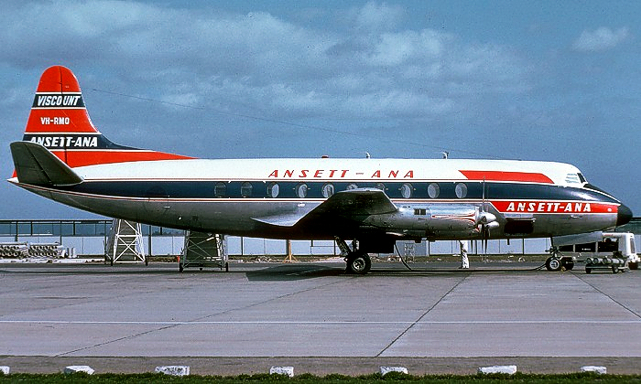
ANSETT-ANA's ex Butler Air Transport V.747 Viscount c/n 97 VH-RMO
I seem to recall, somewhat hazily, that our ex Butler Air Transport V.747s were 48-seaters. I still have all of my (thick)
manuals which I will go through in attempt to confirm the seating configuration. I am sure our V.832s, VH-RMG to RML
inclusive, carried 72 passengers."
Thank you Alan – you always knew those manuals would come in useful again! Seriously though, it is through official
documentation being retained our quest to extend on our virtual museum has become considerably easier and attainable.
 History and photos of Viscount c/n 97 VH-BAT / VH-RMO
History and photos of Viscount c/n 97 VH-BAT / VH-RMO
Getting it right – the 'Ray Charles' Viscount at the Wings of History Museum
Readers who have been following us for a while may recall dialogue that has taken place with regard to the mistaken identity
of the Wings of History Museum Viscount c/n 213 N7458. Brian Burrage tells us;
"Below is a report posted by Gary Schenauer that proves that our efforts to get the history of the Viscount as accurate
as possible, has paid off in assisting Wings of History Museum to correctly identify their Viscount cockpit. The report is as
follows;"
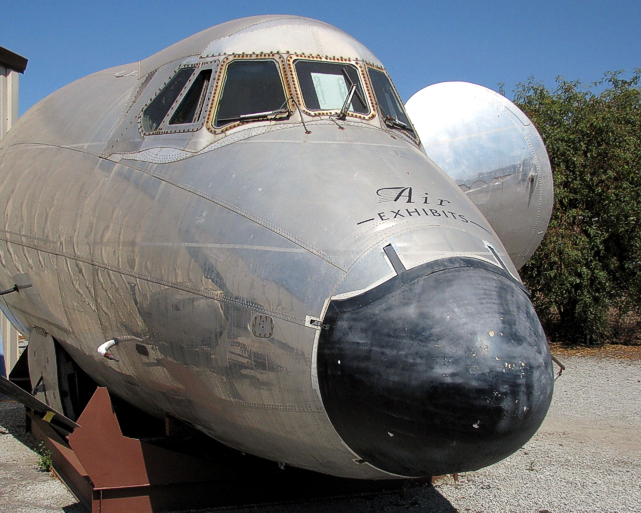
Wings of History Museum Viscount c/n 213 N7458
"On display at the Wings of History Air Museum (South County Airport ... FAA E16), San Martin, CA. This aircraft was originally
purchased and placed in service by Capital Airlines. It was later transferred to United Air Lines in the merger where it was
registered as N7458.
Yesterday, while researching the background of this aircraft and preparing to print and post this photo, I learned there was
some confusion as to the correct identity of this particular Viscount; museum officials are in possession of a document
showing the registration number as being N220RC; however, the correct reg is as indicated above.
The issue is not of grave importance but a Viscount historical group in England was seeking clarification
(www.vickersviscount.net). Using the photos I took two days ago, I was able to locate a single identification number, crop
that section of the photo, and send it to the Viscount historical group founder in England via email.
My photo has proven beyond doubt that, despite the paperwork possessed by museum officials, the aircraft seen in this photo
is c/n 213 N7458 and not c/n 201 N220RC.
N220RC was once owned by singer Ray Charles. N220RC was also used once to transport singer Alice Cooper on his group's concert
tour. This aircraft is not the same plane. Also, it must be stated that museum officials had no knowledge of the
misidentification of the Viscount in their exhibit.
Both Viscounts, N7458 and N220RC, were broken up in Tucson at the same time, and the registration papers for N220RC were
accidentally sent along with this nose section of N7458 to the Wings of History Museum. Museum officials had no way of
knowing the paperwork had been inadvertently swapped."
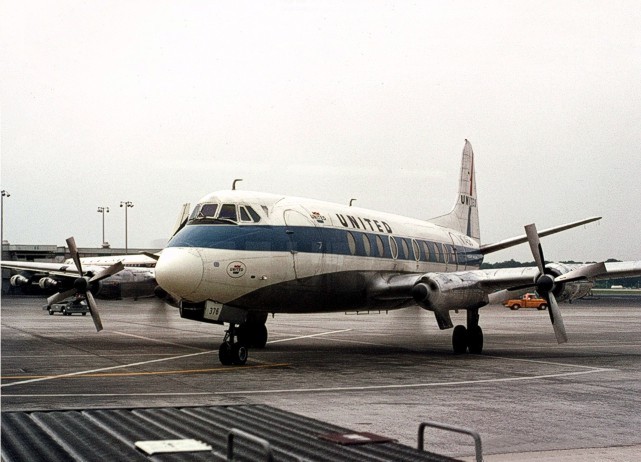
United Air Lines Viscount c/n 213 N7458
Brian continues;
"I have also joined 'Flickr' as 'vickersviscount.net' as there are several information errors on there relating to the Viscount
and by issuing a correction statements we help others get it right and also spread the word about our website. The images of
Viscounts on this site runs into thousands!"
 History and photos of Viscount c/n 201 N7445 / N923RC / N923RA / N500TL / N220RC / XA-MIU
History and photos of Viscount c/n 201 N7445 / N923RC / N923RA / N500TL / N220RC / XA-MIU
 History and photos of Viscount c/n 213 N7458
History and photos of Viscount c/n 213 N7458
As always, if you do see something that you don’t think is right, please let us know and we can check it out. The bigger
our band of followers grows, the more likely it is that we will come up with the correct answer.
David Whitworth photo collection
Are you interested in viewing an enormous selection of aeroplane photos from the 1950s and 1960s? If you are then the David
Whitworth collection will keep you amused for hours – Oh what a great time to be around aircraft!
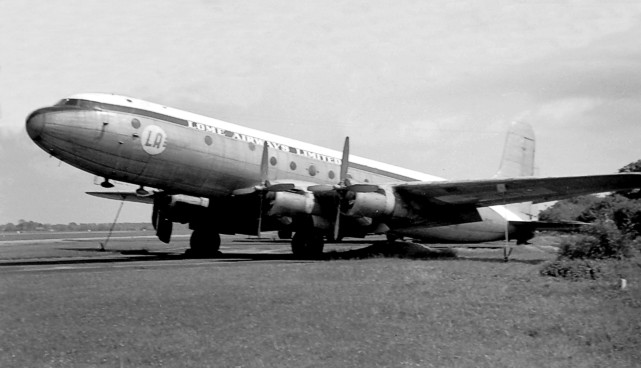
Lome Airways Avro Tudor 5 CF-FCY taken at Stansted, Essex, England
 The David Whitworth collection
The David Whitworth collection
Jet! When Britain Ruled the Skies
This second part of the BBC series celebrating the British aviation industry looks at how, by 1960, the UK's passenger
airline industry was the largest in the world. The development of the Viscount and the Rolls-Royce Dart is featured to
illustrate how Britain was many years ahead of the rest of the world with pioneering aviation technology.
Vickers Viscount Network core member and retired Air Canada Viscount Captain Ron MacDonald was interviewed for this
film from within the cockpit of the Brooklands Museum Viscount c/n 412 G-APIM.
 Jet! When Britain ruled the skies - Part 1 - Military marvels
Jet! When Britain ruled the skies - Part 1 - Military marvels
How to send us feedback, information and photos
We hope that you have enjoyed this issue of our newsletter and would like to hear your view and comments on it. To provide
feedback, or information and photos for inclusion in the virtual museum or our newsletters, please send them to the email
address below.
Photos should be scanned as a JPEG (.jpg) ideally producing an image of at least 600 KB to give us something to work from.
Scanning prints at 600 DPI and slides and negatives at 1,200 DPI usually produces good results.
Don't worry about the condition of your photos as we can work wonders with most images that have strange colours, dust
marks, blemishes, etc.
 Membership@VickersViscount.net
Membership@VickersViscount.net
 Newsletter printable version
Newsletter printable version
Newsletter editorial and production team
Peter Layne - Chief Editor, Wellington, New Zealand.
Ed Jones - Editor, Manchester, England.
Ron MacDonald - Editor, Surrey, England.
Simon Ellwood - Newsletter Production, Leeds, England.
Geoff Blampied - Website Production, Norwich, England
Although every endeavour is made to find an answer to questions, please appreciate that the team here at the Vickers Viscount
Network are all unpaid volunteers who fit this work in with their daytime jobs and chores around home. Any opinions expressed
in this publication are not necessarily those of the Vickers Viscount Network or the newsletter editors and production team.